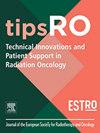Pan-Canadian assessment of image guided adaptive radiation therapy and the role of the radiation therapist
IF 2.8
Q1 Nursing
Technical Innovations and Patient Support in Radiation Oncology
Pub Date : 2025-01-31
DOI:10.1016/j.tipsro.2025.100303
引用次数: 0
Abstract
Purpose
Adaptive radiation therapy (ART) is a close-looped process where anatomic changes observed during treatment are identified, leading to plan modification prior to treatment delivery. The aim of this study was to explore the status of ART across Canada and review the impact of adaptive technologies on the roles and responsibilities of Radiation Therapists (RTTs).
Materials and Methods
Study information and a link to a 30-question survey was sent via email to the RTT manager of all cancer centres across Canada (n = 48). The survey questions included centre demographics, presence of offline and/or online ART activities as standard of care, corresponding roles and responsibilities of the multidisciplinary team, and training activities. The survey was administered electronically and closed after a 3-week accrual period. Responses were analyzed using descriptive statistics.
Results
Thirty-two out of 48 centres responded across all ten provinces (67 % response rate). Twenty-five centres (78 %) currently perform ART, all of which practiced offline ART while 5 practiced online ART. Most common responses for lack of ART were ‘technical limitations’ and ‘lack of resources’. RTTs are responsible for 50 % (offline) versus 58 % (online) ART respectively, with the most notable change being the addition of target delineation to their daily practice.
Conclusions
The status of ART varies across Canada. Offline ART is commonly practiced, but online ART remains an infrequent process due to technical limitations and lack of resources. As centres move towards implementing online ART, the role of the RTT will need to be redefined with corresponding upskilling to support the emergent treatment paradigm.
泛加拿大评估图像引导的适应性放射治疗和放射治疗师的作用
目的适应性放射治疗(ART)是一个闭环过程,在治疗过程中观察到的解剖变化被识别出来,导致在治疗交付之前修改计划。本研究的目的是探索加拿大ART的现状,并回顾适应性技术对放射治疗师(rtt)角色和责任的影响。材料和方法研究信息和30个问题的调查链接通过电子邮件发送给加拿大所有癌症中心的RTT经理(n = 48)。调查问题包括中心人口统计、作为标准护理的线下和/或在线ART活动的存在、多学科团队的相应角色和责任以及培训活动。该调查以电子方式进行,并在3周的累积期后结束。采用描述性统计对反馈进行分析。结果在所有10个省的48个中心中,有32个做出了回应(67%的回复率)。目前有25个中心(78%)开展抗逆转录病毒治疗,所有中心均开展线下抗逆转录病毒治疗,5个中心开展在线抗逆转录病毒治疗。对缺乏抗逆转录病毒治疗最常见的回答是“技术限制”和“缺乏资源”。rtt分别负责50%(离线)和58%(在线)ART,最显著的变化是在其日常实践中增加了目标描述。结论:在加拿大,抗逆转录病毒治疗的现状各不相同。离线ART是一种普遍的做法,但由于技术限制和缺乏资源,在线ART仍然是一个罕见的过程。随着各中心朝着实施在线抗逆转录病毒治疗的方向发展,RTT的作用将需要重新定义,并相应提高技能,以支持紧急治疗模式。
本文章由计算机程序翻译,如有差异,请以英文原文为准。
求助全文
约1分钟内获得全文
求助全文
来源期刊

Technical Innovations and Patient Support in Radiation Oncology
Nursing-Oncology (nursing)
CiteScore
4.10
自引率
0.00%
发文量
48
审稿时长
67 days
 求助内容:
求助内容: 应助结果提醒方式:
应助结果提醒方式:


